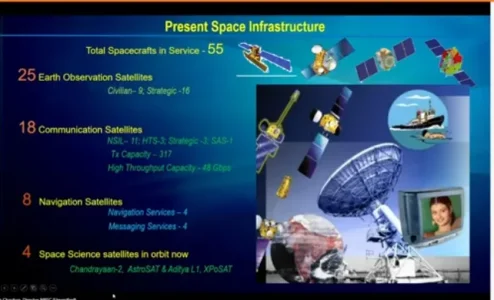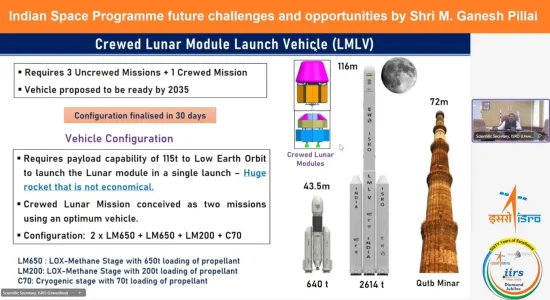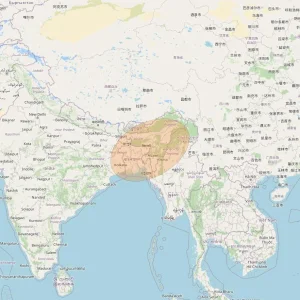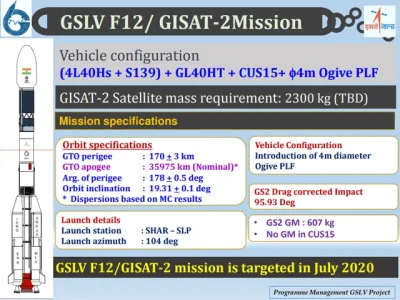You are using an out of date browser. It may not display this or other websites correctly.
You should upgrade or use an alternative browser.
You should upgrade or use an alternative browser.
ISRO - General Discussions (1 Viewer)
- Thread starter Indx TechStyle
- Start date
More options
Who Replied?Is the satellite GSAT-29 otherwise doing well? With the telecom payloads and the remote sensing capability, a first for ISRO in geosynchronous orbit. It was the heaviest satellite lifted by an Indian launcher at the time( Dec/ 2018). It would be reassuring to know that, glitch apart, everything on the satellite is working fine.View attachment 39015
@1:21:45
ABOUT GSAT 29 OPTICAL COMUNNICATION LINK
we are still struggling to establish the communication channel. Although we could locate the satellite, we could establish the link between ground station and the satellite but we are not able to transmit data because of some technical issues which are there on the onboard setter. So now we cannot repair it also. So we are just trying to see doing various experiment for ground to satellite satellite to satellite type of different type of communication data transmission. So this was the precursor the first development of optical link
Only optical communication payload is non responsive rest of it is working in including tr module but optical payload was an experiment for GISAT PROGRAMIs the satellite GSAT-29 otherwise doing well? With the telecom payloads and the remote sensing capability, a first for ISRO in geosynchronous orbit. It was the heaviest satellite lifted by an Indian launcher at the time( Dec/ 2018). It would be reassuring to know that, glitch apart, everything on the satellite is working fine.
It was 4 user spot Ka-band beams and 4 user spot Ku-band beams to provide Village Resource Centres (VRC) in rural areas to bridge the digital divide of users including those in Jammu & Kashmir and North Eastern regions of India. It also features Q/V band payload, optical communication payload and GEO High Resolution Camera (GHRC) camera with telescopeIs the satellite GSAT-29 otherwise doing well? With the telecom payloads and the remote sensing capability, a first for ISRO in geosynchronous orbit. It was the heaviest satellite lifted by an Indian launcher at the time( Dec/ 2018). It would be reassuring to know that, glitch apart, everything on the satellite is working fine.


Satbeams - World Of Satellites at your fingertips
Satbeams - Satellite footprints, news and charts
www.satbeams.com
- Joined
- Apr 22, 2025
- Messages
- 1,425
- Likes
- 3,694
^^^
Thanks, great to know! Incidentally, we hear next to nothing about that high resolution camera on board GSAT 29. By now, 6 and a half years later, you would expect some information to have seeped through to the public. Is it because it's highly classified given its uniqueness and sophistication? If so( and I hope it's that) then best not to probe!
Thanks, great to know! Incidentally, we hear next to nothing about that high resolution camera on board GSAT 29. By now, 6 and a half years later, you would expect some information to have seeped through to the public. Is it because it's highly classified given its uniqueness and sophistication? If so( and I hope it's that) then best not to probe!
Why would ISRO propose a new design over a more economical tri core NGLV ?View attachment 39043
Credits to anshuman titanium sv from twitter
And if you're going for a clean sheet design then why design a complicated & heavy tri-core rocket ?
Dr. S. Somanath Assumes Office as Chancellor of Chanakya University; Reconstituted Board of Governors Announced
Read more At:
Read more At:
View: i was in i was in the review committee member the promotion review committee accepted in may 27 may 23rd in 2017 and they in that meeting once it was over by six o'clock i came back to my guest house and started feeling very uneasy you know i thought then i had started loose motions and then there was an anal bleeding and severe bleeding and i stayed two more days in the taking review and then and i was not able to consider the review but half that time i was sleeping in the sofa in another room side by side this room and then i could barely manage to come and the doctors treated me in ahmedabad for anal bleeding but then on 5th june of that day year we had a gslb launch june 29 in fact i went for that and then there suddenly you know i i treatment i recovered then i went for that and then i started breathing very difficulty again knew i had they i even took some pumps i thought i got sudden asthma and sheary quota and then i started taking these pumps and all and they there one of the directors i will not name him the day he then onfided me that day there is something wrong happened on that day with you i said what is this he says he came to know from some people i even did not give much weight to that i thought okay that is i i actually thought i got a loose something infection has come and they i came back to ahmedabad they gained very difficulty i had a meeting with you know that the agreement was taking amul and in that meeting i could not see people no i came back i called my office doctor that our dispensary she came they looked up they gave certain medicines for all then one of the secret agency people suddenly came to my office then they said sir we have to take you to our doctors because you have been poisoned we want to know what person i said what person is there but my body was deteriorating i was you know there i i was suddenly looking at a mirror i was finding my skins are becoming black i thought maybe i was not well there are a lot of loose motions and a lot of bleeding you know then they checked i had lost already 30 blood and they they they took me and then they cascaded up they took me too many cities aims there were doctors and when i went to amesthey tested already you know that's a all my urine test my hair my male test and all they found that severe presence of arsenic and they infected to the ames doctors that they told me is a very famous who was handling the the susan singh rajput and was handling one a political leader's wife's suspected murder case absolute wife's murder case and all and he was also by treating me he is a forensic expert he is one of the dr sudhir gupta his very one of the top most in fact he touched my feet i told in his
whole lifetime he has seen only cadavers specimen because the numbers that suggest that the exponential fall of the arsenic profile and they it appears i have been paired with a one and a half times the required father but the question was you know there was a letter on you know my skin started peeling off there was a huge fungal infection all of my body then i had a severe neurological issues you know i used to feel some insects are crawling inside my body i know i was not able to walk you know every morning my skins were you know my pit skin they were just getting detached just with the pressure so morning you know the doctor will come and put a paper tape all around so that i'm able to if i touch some paper into the paper will cut my skin and they that if i see the files you know just move shuffle the papers you know my fingers will get cut so i used to use all tapes but then i was told by secret agencies to [Music] help them in the investigation i should put up a very brave face with all difficulties i should attend office and all of that and i did that and this ordeal went for almost three years you know almost 2020 still i have some treatment still going 17 to 20 20.
Last edited:
- Joined
- Jun 13, 2025
- Messages
- 468
- Likes
- 2,017
Isro tests rocket from up.
View: https://x.com/airnewsalerts/status/1934101396179034191?t=1He4jroEvX1DXVQUaFADFQ&s=19
View: https://x.com/airnewsalerts/status/1934101396179034191?t=1He4jroEvX1DXVQUaFADFQ&s=19
Isro tests rocket from up.
View: https://x.com/airnewsalerts/status/1934101396179034191?t=1He4jroEvX1DXVQUaFADFQ&s=19
looks like sounding rocket
Configuration study for a spaceborne Advanced Hyperspectral Imager (AdHYSI) for
Agriculture, Mineralogy and Environmental applications
Ankush Kumar 1*, Nitesh Thapa 1, K. Ajay Kumar 1, B. N. Sharma 1, Arti Sarkar 1, S. S.
Sarkar 1
1Space Applications Centre (ISRO), Ahmedabad 380015
*Corresponding author e-mail: ankush@sac.isro.gov.in
Abstract
Agriculture, Mineralogy and Environmental applications
Ankush Kumar 1*, Nitesh Thapa 1, K. Ajay Kumar 1, B. N. Sharma 1, Arti Sarkar 1, S. S.
Sarkar 1
1Space Applications Centre (ISRO), Ahmedabad 380015
*Corresponding author e-mail: ankush@sac.isro.gov.in
Abstract
Spaceborne hyperspectral imaging sensors have found potential applications in agriculture
science and mineralogical mapping of Earth surface. Recently, there is a growing interest in
using spaceborne hyperspectral data to study impact of agriculture and mining activities on
Earth environment. The prominent spectral signatures from bio-geo-sphere lie in the 400 to
2500 um range of electromagnetic spectrum and a hyperspectral sensor with fine spectral
sampling in this range along with moderate spatial and high temporal resolution can pave way
for enhancing current scientific understanding on various physical processes involving
agriculture, mining and environment as a coupled system. Globally various hyperspectral
sensors such as Hyperion, Envisat, HYSIS, etc have been designed and operationalized for
agriculture, mining and environmental studies. There are several technological challenges in
design and development of these efficient hyperspectral imaging instruments such as covering
large spectral range using a single instrument, achieving higher spectral resolution, radiometric
accuracy, and high SNR in all bands. Due to tremendous progress in detector fabrication
technology, area array detectors operating in broad spectral range of ~400-2500nm are now
available, which can facilitate design and development of hyperspectral imager with a single
instrument. Using innovative design and usage of state-of-the-art electro-optical components
(e.g. detector, grating, filter), challenges can be mitigated.
The present research work proposes an optical imaging spectrometer based on broadband MCT
based cooled detector and convex blazed grating to provide spectral resolution of better than
10nm in the entire operating spectral range of 400-2500nm. Targeted SNR is more than 300
for majority of the spectral range with radiometric resolution of 12 bit. The instrument is
configured to provide 20-30 m spatial resolution and about 20-30 km swath from LEO platform
of about 500 – 600 km altitude and offers 4 days revisit capability with anticipated mission
life of about 5 years.
This paper first discusses the application requirements, presents the system configuration
details of the proposed AdHySI instrument along with the details of optics, detector,
electronics, mechanical and thermal sub-systems. The study brings out various design and
realisation challenges and discusses mitigation approaches. The proposed instrument
configuration is based on the current international trend in hyperspectral instrument technology
and has realisation feasibility. The proposed instrument has potential to become a state-of-the
art spaceborne hyperspectral instrument for agriculture, mineralogy and environmental studies.
science and mineralogical mapping of Earth surface. Recently, there is a growing interest in
using spaceborne hyperspectral data to study impact of agriculture and mining activities on
Earth environment. The prominent spectral signatures from bio-geo-sphere lie in the 400 to
2500 um range of electromagnetic spectrum and a hyperspectral sensor with fine spectral
sampling in this range along with moderate spatial and high temporal resolution can pave way
for enhancing current scientific understanding on various physical processes involving
agriculture, mining and environment as a coupled system. Globally various hyperspectral
sensors such as Hyperion, Envisat, HYSIS, etc have been designed and operationalized for
agriculture, mining and environmental studies. There are several technological challenges in
design and development of these efficient hyperspectral imaging instruments such as covering
large spectral range using a single instrument, achieving higher spectral resolution, radiometric
accuracy, and high SNR in all bands. Due to tremendous progress in detector fabrication
technology, area array detectors operating in broad spectral range of ~400-2500nm are now
available, which can facilitate design and development of hyperspectral imager with a single
instrument. Using innovative design and usage of state-of-the-art electro-optical components
(e.g. detector, grating, filter), challenges can be mitigated.
The present research work proposes an optical imaging spectrometer based on broadband MCT
based cooled detector and convex blazed grating to provide spectral resolution of better than
10nm in the entire operating spectral range of 400-2500nm. Targeted SNR is more than 300
for majority of the spectral range with radiometric resolution of 12 bit. The instrument is
configured to provide 20-30 m spatial resolution and about 20-30 km swath from LEO platform
of about 500 – 600 km altitude and offers 4 days revisit capability with anticipated mission
life of about 5 years.
This paper first discusses the application requirements, presents the system configuration
details of the proposed AdHySI instrument along with the details of optics, detector,
electronics, mechanical and thermal sub-systems. The study brings out various design and
realisation challenges and discusses mitigation approaches. The proposed instrument
configuration is based on the current international trend in hyperspectral instrument technology
and has realisation feasibility. The proposed instrument has potential to become a state-of-the
art spaceborne hyperspectral instrument for agriculture, mineralogy and environmental studies.
ISRS-ISG National Symposium

Attachments
Payload can be used to detect camaflouge of adverseryConfiguration study for a spaceborne Advanced Hyperspectral Imager (AdHYSI) for
Agriculture, Mineralogy and Environmental applications
Ankush Kumar 1*, Nitesh Thapa 1, K. Ajay Kumar 1, B. N. Sharma 1, Arti Sarkar 1, S. S.
Sarkar 1
1Space Applications Centre (ISRO), Ahmedabad 380015
*Corresponding author e-mail: ankush@sac.isro.gov.in
Abstract
Spaceborne hyperspectral imaging sensors have found potential applications in agriculture
science and mineralogical mapping of Earth surface. Recently, there is a growing interest in
using spaceborne hyperspectral data to study impact of agriculture and mining activities on
Earth environment. The prominent spectral signatures from bio-geo-sphere lie in the 400 to
2500 um range of electromagnetic spectrum and a hyperspectral sensor with fine spectral
sampling in this range along with moderate spatial and high temporal resolution can pave way
for enhancing current scientific understanding on various physical processes involving
agriculture, mining and environment as a coupled system. Globally various hyperspectral
sensors such as Hyperion, Envisat, HYSIS, etc have been designed and operationalized for
agriculture, mining and environmental studies. There are several technological challenges in
design and development of these efficient hyperspectral imaging instruments such as covering
large spectral range using a single instrument, achieving higher spectral resolution, radiometric
accuracy, and high SNR in all bands. Due to tremendous progress in detector fabrication
technology, area array detectors operating in broad spectral range of ~400-2500nm are now
available, which can facilitate design and development of hyperspectral imager with a single
instrument. Using innovative design and usage of state-of-the-art electro-optical components
(e.g. detector, grating, filter), challenges can be mitigated.
The present research work proposes an optical imaging spectrometer based on broadband MCT
based cooled detector and convex blazed grating to provide spectral resolution of better than
10nm in the entire operating spectral range of 400-2500nm. Targeted SNR is more than 300
for majority of the spectral range with radiometric resolution of 12 bit. The instrument is
configured to provide 20-30 m spatial resolution and about 20-30 km swath from LEO platform
of about 500 – 600 km altitude and offers 4 days revisit capability with anticipated mission
life of about 5 years.
This paper first discusses the application requirements, presents the system configuration
details of the proposed AdHySI instrument along with the details of optics, detector,
electronics, mechanical and thermal sub-systems. The study brings out various design and
realisation challenges and discusses mitigation approaches. The proposed instrument
configuration is based on the current international trend in hyperspectral instrument technology
and has realisation feasibility. The proposed instrument has potential to become a state-of-the
art spaceborne hyperspectral instrument for agriculture, mineralogy and environmental studies.
ISRS-ISG National Symposium
View attachment 39749
Is the satellite GSAT-29 otherwise doing well? With the telecom payloads and the remote sensing capability, a first for ISRO in geosynchronous orbit. It was the heaviest satellite lifted by an Indian launcher at the time( Dec/ 2018). It would be reassuring to know that, glitch apart, everything on the satellite is working fine.



Detection and Identification of Camouflaged Targets using Hyperspectral and LiDAR dataPayload can be used to detect camaflouge of adversery
Attachments
Users who are viewing this thread
Total: 1 (members: 0, guests: 1)

Latest Replies
-
Indo US Relations
- shade2
-
Indian Economy
- Ajayant Tripathi
-
Air India AI 171 Crash in Ahmedabad
- cicada3307
-
Operation Sindoor & Aftermath
- rockdog
-
Indian Navy Developments & Discussions
- liberalredditor
-
Indian Infrastructure & Discussion
- ArjunMK1A
-
Indian Small Arms & Weapons
- RDXChauhan
-
Indian Special Forces
- TAVOUR 21











